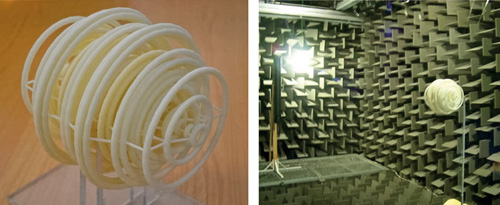By Tushna Commissariat

A picture of the 3D acoustic cloak (left) and the cloak being tested in an anechoic chamber (right). (Courtesy: Physical Review Letters)
Invisibility cloaks seem to fascinate scientists and the public in equal measure, and every few months a novel design for some sort of metamaterial that cloaks either light or sound catches our eye, if you excuse the pun.
This week, we came across a group of researchers in Spain that claims to have designed, fabricated and tested the first “directional 3D acoustic cloak” that works for airborne sound. Previous designs of acoustic cloak work in water and air, but only if the sound propagates in 2D. Also, many cloaks only work within a narrow band of frequencies, limiting their uses.
However, José Sánchez-Dehesa, of the Polytechnic University of Valencia and who has worked on many acoustic-cloak designs, and colleagues’ 3D cloak is made up of 60 concentric acoustically rigid rings that would surround the object to be cloaked – a sphere of radius 4 cm. According to their paper (published in Physical Review Letters), the distribution of concentric rings is determined by the direction in which the sound propagates. “The positions and major radii of the [rings] surrounding the sphere are determined such that they cancel the field scattered by the sphere,” according to the researchers, and these positions are “obtained through an optimization technique that combines a genetic algorithm and simulated annealing”.
The team printed a prototype of its cloak design using a 3D printer and tested it in an anechoic chamber. The researchers found that their “low-loss fabricated cloak” reduces the intensity of the waves scattered by the sphere by 90% at 8.55 kHz.
The team does acknowledge that the cloak is directional and narrow-banded, but says that improvements can be made. The scientists suggest that certain modifications could be made so that the cloak is both broadband and omnidirectional. They also say that cloaks for underwater operation could also be possible using this design, by introducing elasticity to the rings used.
Guidelines
Show/hide formatting guidelines
this text was deletedwhere people live in harmony with nature and animals</q>
Some text